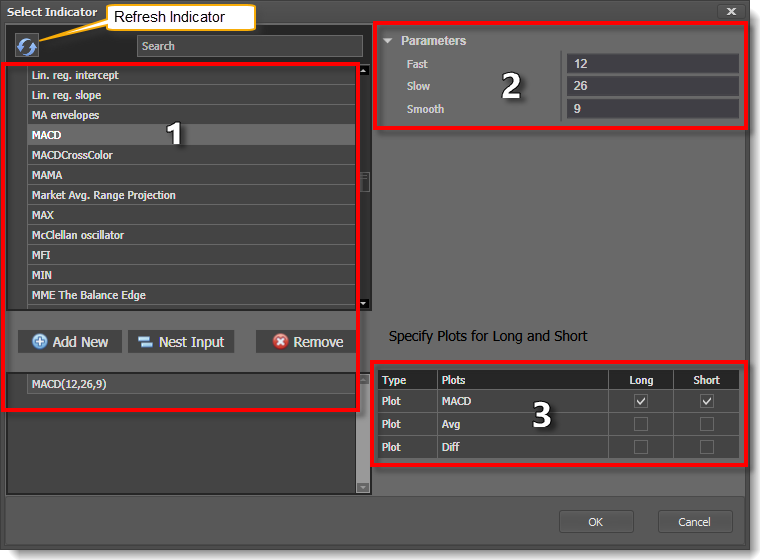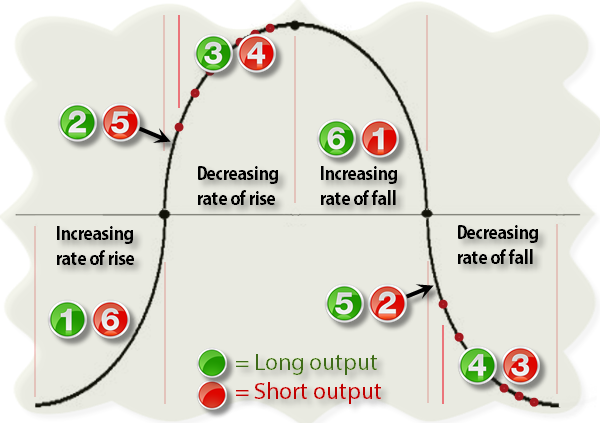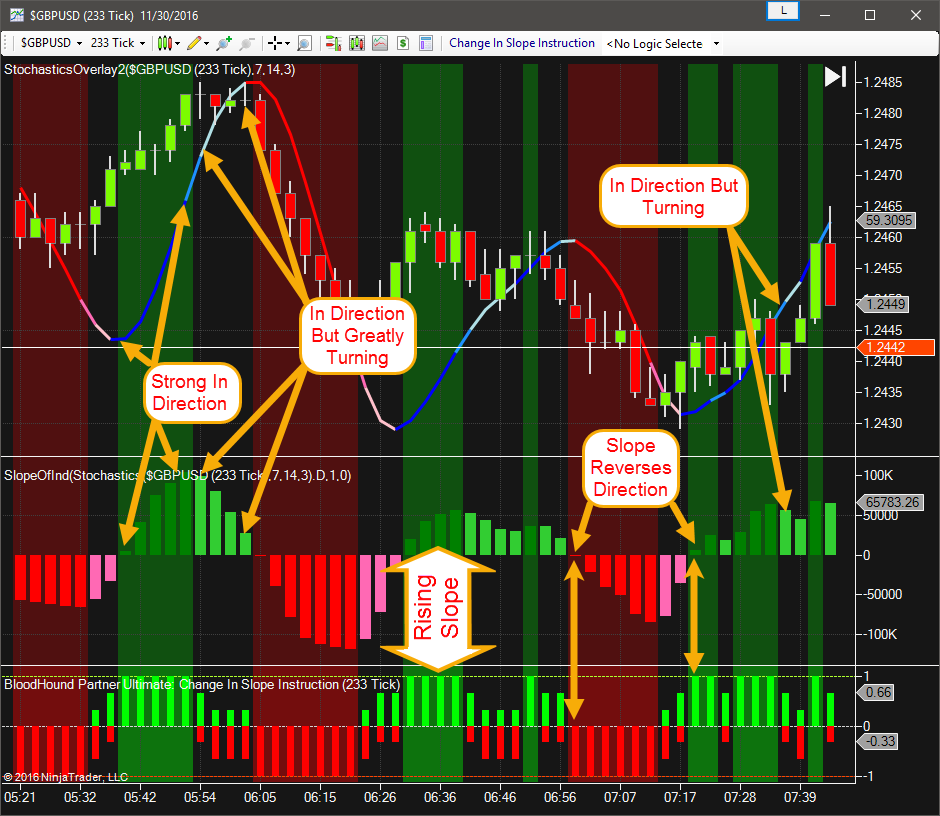Change In Slope Solver
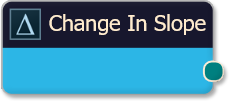
The Change In Slope solver determines if the slope of an indicator is continuing to increase, starting to decrease, or reversing.
This solver is useful for detecting when an oscillator or moving average is starting to roll over and reverse direction. For example, when the Stochastic is rising, the closer it gets to 100, the rising slope will begin to flatten out or roll over before it reverses down. The video below will explain in more detail.
BloodHound v2
Properties tab
Properties tab
This section provides quick access to commonly used output modifiers.
Please note: The buttons only modify the individual instance of the selected node(s) on a Logic Board. Thus, the buttons are only visible when a node is selected on the Logic Board. The buttons are not available when a solver is selected in the Solvers panel, because the original solver's output can not be globally modified.
This behavior is consistent with adding a function node afterwards, so that the original solver's output remains unmodified elsewhere in the system. It is similar to having an SMA(50) on several charts. Changing the plot color on one chart does not modify the plot color on the other charts.
Global Properties
Global Properties
Behavior
Input
This section determines what kind of data the solver will evaluate. Use the Type drop-down menu to select the data type.
The menu will change based on which data type is selected. Click on Type to see the various data types available and the corresponding documentation.
The Input section determines the data type to be evaluated. Use the 'Type' menu to select the data type. See below for detailed information on each data type.
Type: Fixed Value
Type: Price
This option allows price data to be used in the solver. The price data can be shaped/manipulated by the various settings before it is used by the solver.
Custom Prices
SharkIndicators has custom system development prices that are very useful in reducing the number of solvers, and simplifying system logic, when evaluating the open and close (body) prices.
Body Top: Regardless of the bar direction, this returns the upper price of the candlestick body. Either the close or open price. Whichever is on top. e.g. For an up bar, the Body Top equals the close price.
Body Median: This returns the median price of the candlestick body. The formula is (Close + Open) ÷ 2.
Body Bottom: Regardless of the bar direction, this returns the lower price of the candlestick body. Either the close or open price. Whichever is the bottom. e.g. For an up bar, the Body Bottom equals the open price.
Type: Volume
Volume will feed the current bar volume into the solver.
To evaluate the volume from a few bars back, use Indicator Value. Then select the VOL indicator, and use the Displacement setting.
Type: Indicator Value
Type: Swing Point Prices
Swing Point Prices uses the Swing Highs & Lows indicator plots for input price data. This is useful when you need to access the lowest low or highest high prices from the latest swing point.
You can add the bundled indicator Swing Highs & Lows to the chart to help you visualize the price data the solver is using.
Type: Linear Regression Channel
Output
Options tab
Options tab
This section is used to modify the node's final output value. It is only useful for designing fuzzy logic systems, or a fuzzy logic section of a system.
Please note: The Weight controls only modify the individual instance of the selected node(s) on a Logic Board. Thus, the Weight controls are only visible when a node is selected on the Logic Board. The controls are not available when a solver is selected in the Solvers panel, because the original solver's output can not be globally modified.
This behavior is different than BloodHound 1.0. In BH 1.0, the Weight controls modified the nodes output globally (every instance). This change in BH 2.0 adds more system design granularity.
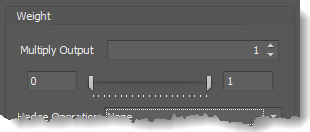 Multiply Output: This takes the internal values (the Long and Short values determined via the Properties tab » Output Rules section) and multiplies them by this value. Note: the final output will not exceed a value of 1, as described in the Slider control below.
Multiply Output: This takes the internal values (the Long and Short values determined via the Properties tab » Output Rules section) and multiplies them by this value. Note: the final output will not exceed a value of 1, as described in the Slider control below.
Slider control: The slider constrains the final output to a value of 0 to 1. The left side of the slider sets a minimum value that is output regardless if the solver condition is true or not. The right side sets a maximum value that is output. The output is capped.
e.g. Three indicator conditions are being checked, and thus three solvers are created. Only two out of the three indicator conditions are needed. An Additive logic node is used to add the solver's outputs together. Just two out of the three solvers need to add up to a value of 1. Therefore, the right slider (max output value) for all three solvers is set to 0.5. When two indicator/solver conditions are found, thus the outputs = 0.5, then the calculation, in the Additive node, is 0.5 + 0.5 + 0 = 1. A value of 1 means the two out of three condition is true.
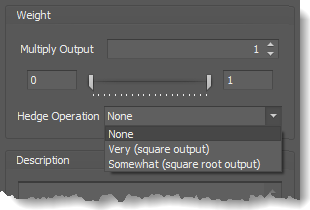 Hedge Operation: This applies a mathematical formula to the internal value.
Hedge Operation: This applies a mathematical formula to the internal value.
None: No modification is applied.
Very (square output): A squaring formula is applied. Output = value^² .
Somewhat (square root output): A square root formula is applied. Output = √value .
Description
Description
This text area provides a place to write a full description of what the node is doing, used for, or what ever you want.
Note: The Description is global to all instances of the node. It is not applied individually to each instance as the Weight controls are.
Help tab
Help tab
This tab displays the documentation page (from this web site) of the selected node.
Please note: NinjaTrader v8.0.26.0 or newer is required for the built in web viewer to work, and thus the documentation to be displayed.
Video Tutorial
For more benefit please watch in full screen mode, as this video is recorded in HD.
Examples
Example 1: The Basics
This demonstrates the basic function of Indicator Change In Slope solver with the use of the Stochastic D. This Solver will be used to measure strength in the Stochastic D by comparing the current slope to the previous bar’s slope. When the slope continues to increase in the same direction it is considered Strong In Direction. If the slope begins to decreases in rate the first bar is considered In Direction But Turning. Any bar afterwards is considered In Direction But Greatly Turning until the slope reverses direction.
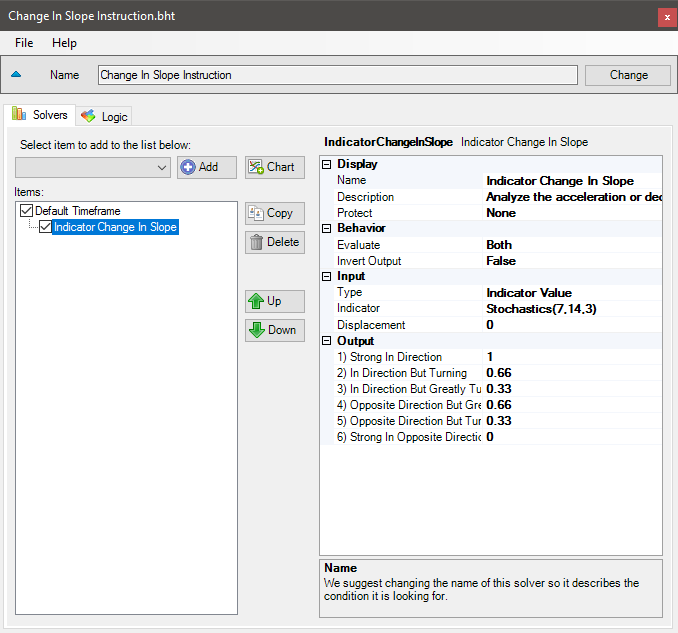
- Add the Indicator Change In Slope solver.
The chart below has a multi colored Stochastic D overlaid on price, and an indicator representing the slope of the Stochastic D. Notice how the Solver output of 1 coincides with the continuous slope increase whether it is to the down side or up side. And, when the slope rate decreases the output decreases until the slope reverses.
Example 2: Cycle Warning
This example checks the slope condition of the HMA and the Stochastic D cycle position to create a warning condition. The Indicator Change In Slope solver checks the HMA for a possible reverse in direction. As a filter, the Indicator Threshold solver will check the Stochastic D for an over sold or over bought condition.

- Add the Indicator Change In Slope solver.
- Set the Indicator to HMA 17 period.
- Set Output 1), 2), & 3) to 0
- Set Output 4) to 1
- Set Output 5) to 0.5
- Add the Indicator Threshold solver.
- Set the Indicator to Stochastic using the default settings
- Set Thresholds to the following: A = 80, B = 80, C = 50, D = 20 & E = 20
- Set Long Output At E to 1
- Set Short Output At A to 1
The chart below has a multi colored Stochastic D overlaid on price with 20 & 80 gray dashed lines, and a white HMA 17 period. Notice how a warning signal only occurs when the Stochastic reaches an extreme condition, and the chop in the middle of the chart is ignored.
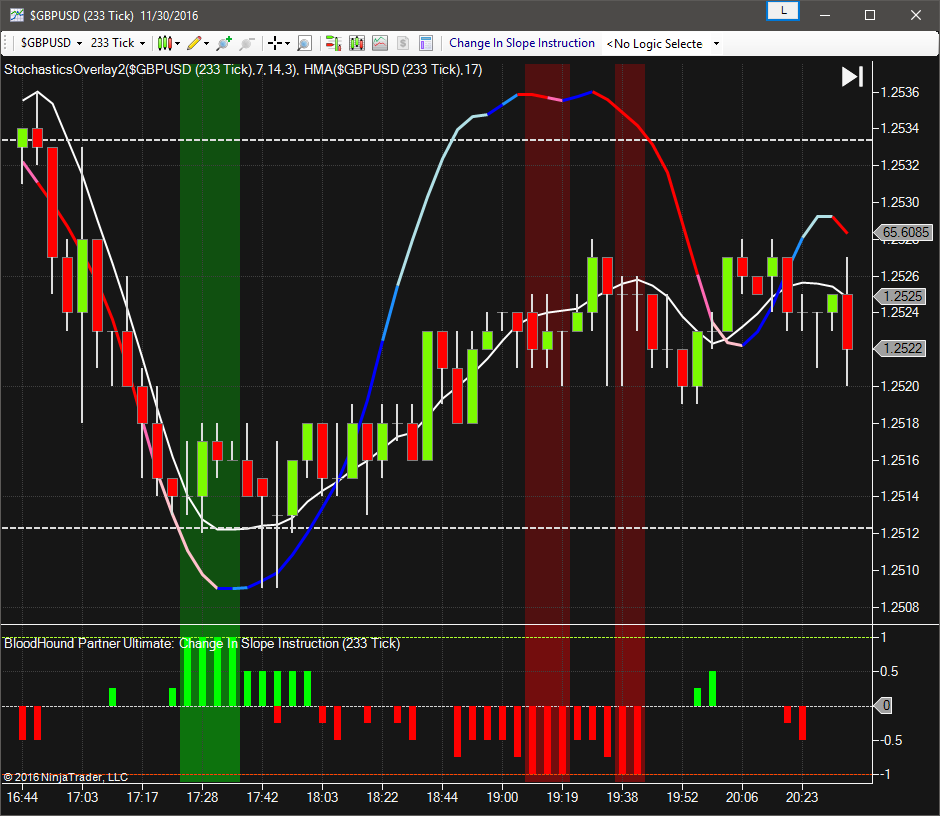
BloodHound v1
Indicator Change In Slope
Parameters
Input
Output
Video Tutorial
This video is from our weekly Workshop on April 4th, 2015.
For more benefit please watch in full screen mode, as this video is recorded in HD.
Examples
Example 1: The Basics
This demonstrates the basic function of Indicator Change In Slope solver with the use of the Stochastic D. This Solver will be used to measure strength in the Stochastic D by comparing the current slope to the previous bar’s slope. When the slope continues to increase in the same direction it is considered Strong In Direction. If the slope begins to decreases in rate the first bar is considered In Direction But Turning. Any bar afterwards is considered In Direction But Greatly Turning until the slope reverses direction.

- Add the Indicator Change In Slope solver.
The chart below has a multi colored Stochastic D overlaid on price, and an indicator representing the slope of the Stochastic D. Notice how the Solver output of 1 coincides with the continuous slope increase whether it is to the down side or up side. And, when the slope rate decreases the output decreases until the slope reverses.
Example 2: Cycle Warning
This example checks the slope condition of the HMA and the Stochastic D cycle position to create a warning condition. The Indicator Change In Slope solver checks the HMA for a possible reverse in direction. As a filter, the Indicator Threshold solver will check the Stochastic D for an over sold or over bought condition.

- Add the Indicator Change In Slope solver.
- Set the Indicator to HMA 17 period.
- Set Output 1), 2), & 3) to 0
- Set Output 4) to 1
- Set Output 5) to 0.5
- Add the Indicator Threshold solver.
- Set the Indicator to Stochastic using the default settings
- Set Thresholds to the following: A = 80, B = 80, C = 50, D = 20 & E = 20
- Set Long Output At E to 1
- Set Short Output At A to 1

